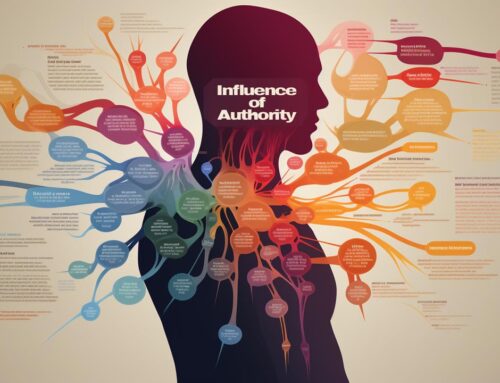Understanding the mechanisms behind human behavior and decision-making has become critical. One intriguing aspect of human psychology is how easily the human mind can be influenced by external factors. Whether it’s advertising, social pressure, or cognitive biases, our minds are susceptible to various influences that can shape our thoughts, beliefs, and actions.
This article delves into the fascinating topic of why the human mind is easily influenced. We will explore the psychological and neurological underpinnings that make us vulnerable to external manipulation. Through comprehensive research, expert opinions, and real-life examples, this article aims to shed light on the complex interplay between our minds and external influences.
The Power of Persuasion Part 1. Why is the Human Mind Easily Influenced?
Table of Contents
- The Power of Persuasion
- The Psychology of Persuasion
- Emotional Appeals
- Appeals to Values and Beliefs
- Reciprocity and Social Proof
- Authority and Credibility
- Scarcity and Fear of Missing Out (FOMO)
- Consistency and Commitment
- Framing and Language
The Power of Persuasion
The power of persuasion is a fundamental aspect of human communication that plays a significant role in influencing the human mind. Persuasion is the art of convincing others to adopt a certain belief, opinion, or behavior through various communication techniques. It is a skill honed by marketers, politicians, salespeople, and influential figures to sway public opinion, change behaviors, and achieve specific outcomes.
Understanding how persuasion works is crucial for comprehending why the human mind is easily influenced. Let’s delve deeper into the mechanisms and strategies of persuasion:
The Psychology of Persuasion
The psychology of persuasion delves into the intricate workings of the human mind and how various psychological factors influence our responses to persuasive messages. By understanding these underlying mechanisms, marketers, advertisers, and influential figures can craft more effective strategies to sway opinions, change behaviors, and achieve their desired outcomes. Let’s explore some essential aspects of the psychology of persuasion:
Cognitive Biases and Persuasion
Cognitive biases are systematic patterns of thinking that can lead to deviations from rational judgment. They impact how we process information, make decisions, and respond to persuasive messages. Understanding common cognitive biases, such as confirmation bias, availability heuristic, and anchoring, can help persuasive communicators tailor their messages to align with these biases, increasing the chances of acceptance.
Emotional Appeals and Persuasion
Emotions play a central role in decision-making and persuasion. Messages that trigger strong emotional responses can create lasting impressions and influence behavior. Emotions like fear, joy, anger, and empathy can lead individuals to adopt particular beliefs or take specific actions.
Social Influence and Persuasion
Humans are social creatures, and social influence profoundly impacts our decision-making processes. People often look to others for cues on how to behave, especially in uncertain situations. The principles of social proof, conformity, and obedience come into play, allowing persuasive communicators to leverage the influence of the crowd or authority figures to shape opinions.
The Power of Storytelling
Storytelling is a powerful tool in persuasion. Narratives have a unique ability to captivate audiences and convey complex ideas in a relatable and memorable manner. Stories elicit emotional responses, making persuasive messages more engaging and persuasive.
Understanding Needs and Desires
Effective persuasion involves understanding the needs, desires, and motivations of the target audience. By tapping into these underlying drivers, communicators can tailor their messages to resonate with individuals on a personal level, increasing the likelihood of acceptance.
The Role of Trust and Likeability
Trust and likeability are crucial factors in persuasion. People are more likely to be persuaded by those they trust and find likable. Building rapport, credibility, and authenticity can enhance the persuasive impact of messages.
Overcoming Resistance
Resisting persuasion is a natural human tendency. When people perceive attempts at manipulation or coercion, they may become defensive and resistant. Effective persuasive communicators employ techniques to minimize resistance, such as using the “foot-in-the-door” approach or framing messages in a non-threatening manner.
Understanding the psychology of persuasion empowers individuals to be more discerning consumers of information and recognize when they are being influenced. It also equips communicators with ethical guidelines for crafting persuasive messages that respect the autonomy and agency of their audience. Ultimately, the art of persuasion should be used responsibly and ethically to foster positive change and informed decision-making.
Emotional Appeals
Emotional appeals are a potent aspect of persuasion that leverages human emotions to influence beliefs, attitudes, and behaviors. Emotions play a critical role in decision-making, and persuasive communicators often capitalize on this by crafting messages that trigger specific emotional responses. Understanding the mechanics of emotional appeals helps marketers, advertisers, and communicators create impactful messages that resonate deeply with their target audience. Let’s explore the various aspects of emotional appeals:
Understanding the Role of Emotions
Emotions are complex psychological and physiological responses to stimuli. They influence our perceptions, attitudes, and decisions. Persuasive communicators study the emotional triggers that resonate most with their target audience, enabling them to design messages that evoke the desired emotional responses.
The Power of Emotional Engagement
Emotional engagement creates a lasting impact on the audience. When individuals connect emotionally with a message, they are more likely to remember it and be moved to action. Emotional appeals can forge strong bonds between brands and consumers or rally support for a cause.
Types of Emotional Appeals
Different emotions can be harnessed to achieve specific persuasive outcomes. Some common emotional appeals include fear, happiness, anger, and sadness.
Fear and Anxiety
Fear is a powerful motivator that prompts individuals to take action to avoid potential threats or negative outcomes. Advertisements warning about health risks or urging environmental conservation often utilize fear appeals.
Happiness and Joy
Positive emotions like happiness and joy can create positive associations with a product, service, or cause. Feel-good marketing campaigns and heartwarming stories often evoke happiness to foster brand loyalty.
Anger and Outrage
Anger and outrage can be harnessed to mobilize individuals for social or political causes. Messages that highlight injustices or call for change often evoke anger to spur action.
Sadness and Empathy
Appeals to sadness and empathy can generate compassion and solidarity. Charity campaigns often use emotional stories to elicit donations and support for those in need.
Creating Emotional Resonance
To be effective, emotional appeals must resonate with the audience’s values, experiences, and aspirations. Understanding the target demographic and tailoring messages to align with their emotional needs enhances the persuasive impact.
Ethics and Emotional Appeals
While emotional appeals can be powerful tools, ethical considerations are essential. Manipulative or exploitative emotional appeals may be perceived negatively and damage trust with the audience. Balancing emotional resonance with ethical messaging is crucial for long-term success.
Case Studies of Effective Emotional Appeals
Examining real-life examples of successful emotional appeals in advertising, social movements, and political campaigns offers valuable insights into the mechanics of emotional persuasion.
Emotional appeals are a compelling aspect of persuasion that can shape attitudes, influence decisions, and inspire action. By tapping into the emotional core of the audience, communicators can create messages that leave a lasting impact and foster meaningful connections with their target demographic. However, it is essential to approach emotional appeals ethically and responsibly, respecting the emotions and agency of the audience.
Appeals to Values and Beliefs
Appeals to values and beliefs are powerful persuasive techniques that leverage individuals’ core principles, moral compass, and deeply held convictions to influence their attitudes and behaviors. By aligning persuasive messages with the values and beliefs of the target audience, communicators can establish a strong emotional connection and foster a sense of identification. Understanding how values and beliefs impact decision-making enables marketers, advertisers, and leaders to craft messages that resonate authentically with their audience. Let’s explore the various aspects of appeals to values and beliefs:
Understanding Values and Beliefs
Values are fundamental beliefs that guide individuals’ behavior and shape their preferences and priorities. Beliefs, on the other hand, are the acceptance of certain ideas or concepts as true or real. Both values and beliefs play a crucial role in shaping an individual’s identity and worldview.
The Role of Values in Decision-Making
Values are at the core of decision-making. People tend to align their choices with their values, seeking consistency between their actions and their deeply held beliefs. Appeals to values tap into this alignment, making the persuasive message more convincing and compelling.
Identifying Target Audience Values
To effectively appeal to values and beliefs, communicators must understand their target audience deeply. Conducting thorough market research, surveys, and audience analysis can help identify the values and beliefs that resonate most with the intended recipients.
Building Authenticity and Trust
Value-based appeals must be authentic and genuine. Attempting to manipulate or exploit values can lead to a loss of trust and credibility. Establishing a transparent and sincere approach is essential for long-term success.
Appealing to Shared Beliefs
Appeals to shared beliefs can foster a sense of belonging and community. When a message aligns with a group’s shared values and beliefs, it can strengthen group identity and create a collective commitment to the cause.
Case Studies of Effective Value-Based Appeals
Analyzing successful marketing campaigns, social movements, or political messages that effectively tapped into values and beliefs can provide valuable insights into the strategies behind their impact.
Ethics of Value-Based Appeals
While values and beliefs can be compelling tools for persuasion, ethical considerations are paramount. Communicators must ensure that their appeals align with genuine values and do not manipulate or deceive the audience.
Appeals to values and beliefs can create deep emotional connections with the audience, leading to lasting changes in attitudes and behaviors. By understanding the role of values in decision-making and appealing to shared beliefs authentically, persuasive communicators can inspire positive actions and foster meaningful relationships with their target audience. Ethical considerations and transparency are crucial to maintaining trust and credibility while leveraging this influential persuasive technique.
Reciprocity and Social Proof
Reciprocity and social proof are powerful psychological principles that play a significant role in influencing human behavior. As social creatures, humans are wired to respond to certain cues in our environment, and skilled communicators can harness these principles to shape opinions and encourage specific actions. Understanding the mechanics of reciprocity and social proof helps marketers, advertisers, and leaders design persuasive strategies that capitalize on these fundamental drivers of human behavior. Let’s explore each principle in detail:
Reciprocity: The Law of Giving and Receiving
Reciprocity is a social norm present in various cultures, emphasizing the obligation to repay a favor or act of kindness. When someone does something for us, we feel an internal urge to reciprocate, creating a cycle of mutual giving and receiving. Reciprocity is deeply ingrained in human interactions and can significantly impact decision-making.
The Power of Obligation
Reciprocity triggers a sense of obligation within individuals. When offered something of value, people often feel compelled to return the favor, making it a persuasive technique to elicit compliance and cooperation.
Reciprocity in Marketing and Sales
Marketers often use the principle of reciprocity to provide free samples, discounts, or valuable content to potential customers. By offering something of value first, they create a sense of indebtedness, increasing the likelihood of a positive response to subsequent requests.
Social Proof: Following the Crowd
Social proof is the idea that people tend to follow the actions of others, especially when they are uncertain about what to do. When we observe others behaving in a particular way, we assume it is the correct behavior and are more inclined to mimic it.
The Influence of Conformity
Conformity is closely related to social proof, where individuals adjust their beliefs or behaviors to match those of a group. The desire to fit in and be accepted drives us to adopt the norms and behaviors of the majority.
Social Proof in the Digital Age
The rise of social media and online reviews has amplified the impact of social proof. Consumers often base their purchasing decisions on product ratings, customer reviews, and the number of social media likes or followers.
Case Studies of Effective Reciprocity and Social Proof
Examining real-life examples of successful reciprocity and social proof strategies provides insights into their effectiveness and implementation.
Ethics of Reciprocity and Social Proof
While reciprocity and social proof can be persuasive tools, ethical considerations are crucial. Manipulative or deceptive use of these principles can harm trust and relationships with the audience.
Reciprocity and social proof are potent drivers of human behavior, shaping our decisions, beliefs, and actions. By understanding these principles, communicators can create persuasive messages that leverage the power of giving, obligation, and social influence. However, ethical application is vital to maintaining authenticity and building lasting connections with the audience.
Authority and Credibility
The influence of authority and credibility on human behavior is a well-documented psychological phenomenon. People tend to defer to individuals they perceive as knowledgeable, trustworthy, and possessing expertise in a particular domain. Skilled communicators can leverage the principle of authority to persuade and guide the opinions and actions of others. Understanding the dynamics of authority and credibility empowers marketers, leaders, and influencers to establish a strong presence and gain the trust of their audience. Let’s explore the various aspects of authority and credibility:
The Impact of Authority
Authority is the perceived power, expertise, or knowledge an individual or entity holds within a specific context. People tend to respect and follow the instructions or advice of authoritative figures, as they assume these figures possess greater knowledge and wisdom.
The Role of Expertise
Expertise is a key factor in establishing authority and credibility. When individuals demonstrate high levels of knowledge and skill in a particular domain, others are more inclined to trust their judgment and opinions.
Perceptions of Trustworthiness
Credibility is closely linked to perceptions of trustworthiness. People are more likely to be persuaded by communicators they perceive as honest, reliable, and having their best interests at heart.
Establishing Credibility
Building credibility is essential for gaining the trust and respect of an audience. Several strategies can enhance credibility:
Credentials and Qualifications
Highlighting relevant credentials, qualifications, and achievements helps establish expertise and authority in a particular field.
Consistency and Reliability
Consistent and reliable behavior reinforces credibility. Delivering on promises and maintaining a track record of trustworthiness fosters long-term credibility.
Transparency and Honesty
Openness and honesty are essential for building trust. Admitting mistakes and being transparent about intentions can enhance credibility.
The Influence of Authority Figures
The presence of authority figures can significantly impact decision-making and behavior. From following the advice of experts to conforming to the instructions of leaders, authority figures wield considerable influence.
Using Authority in Marketing and Leadership
Authority is often used in marketing and leadership to persuade and guide consumers or team members. Endorsements from authoritative figures and the use of expert opinions can enhance a product’s or brand’s credibility.
Challenges and Ethical Considerations
While authority and credibility can be persuasive tools, ethical considerations are crucial. Misusing or misrepresenting authority can lead to a breach of trust and damage relationships with the audience.
Case Studies of Effective Authority and Credibility
Analyzing real-life examples of successful authority and credibility strategies provides insights into their impact and implementation.
Authority and credibility are powerful forces that shape how individuals perceive and respond to information. By understanding the role of expertise, trustworthiness, and transparency, communicators can build credibility and gain the respect and loyalty of their audience. Ethical use of authority is vital for maintaining authenticity and fostering lasting connections with followers, customers, and team members.
Scarcity and Fear of Missing Out (FOMO)
Scarcity and the fear of missing out (FOMO) are psychological principles that tap into humans’ innate desire for exclusivity and the fear of being left out. These principles are powerful drivers of human behavior and play a significant role in influencing decision-making and purchase choices. By leveraging scarcity and FOMO, marketers and advertisers can create a sense of urgency and desirability, encouraging individuals to act quickly to avoid missing out on valuable opportunities. Let’s delve into the intricacies of scarcity and FOMO:
Understanding Scarcity and FOMO
Scarcity refers to the limited availability of a product, service, or opportunity. FOMO, on the other hand, is the anxiety or fear of missing out on something desirable or valuable.
The Impact of Perceived Exclusivity
When something is scarce or perceived as exclusive, its perceived value increases. Individuals are more inclined to desire and pursue items that are difficult to obtain, associating rarity with higher quality or status.
Creating a Sense of Urgency
Scarcity and FOMO create a sense of urgency in individuals. The fear of missing out on something special or time-limited motivates them to act quickly, lest they lose the opportunity.
Limited-Time Offers and Product Scarcity
Limited-time offers and product scarcity are common strategies used in marketing. Time-limited promotions or limited stock availability compel consumers to make immediate decisions.
Fear of Missing Out (FOMO) and Social Media
Social media platforms are fertile grounds for triggering FOMO. Constant updates on friends’ activities, events, and experiences can create a sense of missing out on exciting or rewarding experiences.
Psychological Triggers and FOMO
Several psychological factors contribute to FOMO, such as the fear of regret, the need for social acceptance, and the desire to be part of a group or trend.
Overcoming Resistance to Scarcity and FOMO
While scarcity and FOMO can be persuasive techniques, some individuals may resist feeling pressured or manipulated. Employing transparency and authenticity can help overcome resistance.
Ethics of Scarcity and FOMO
Ethical considerations are crucial when using scarcity and FOMO. Communicators must be mindful not to deceive or create false urgency to exploit consumers.
Case Studies of Effective Scarcity and FOMO
Analyzing real-life examples of successful scarcity and FOMO strategies provides insights into their effectiveness and ethical implementation.
Scarcity and the fear of missing out are potent triggers that influence decision-making and consumer behavior. By creating a sense of exclusivity and urgency, marketers can appeal to individuals’ desires for unique experiences and possessions. However, ethical application is essential to avoid manipulative practices and maintain trust with the audience. When used responsibly, scarcity and FOMO can be effective tools to drive action and engagement.
Consistency and Commitment
Consistency and commitment are psychological principles that play a significant role in shaping human behavior and decision-making. People have a natural inclination to align their actions and beliefs with their previous commitments to maintain a sense of internal coherence and identity. By leveraging consistency and commitment, communicators can encourage individuals to stay true to their prior choices and beliefs, making it easier to influence future decisions. Understanding the dynamics of consistency and commitment allows marketers, advertisers, and leaders to design persuasive strategies that foster long-term engagement and loyalty. Let’s explore each principle in detail:
The Power of Consistency
Consistency is the desire to act in alignment with our previous choices, beliefs, and commitments. People seek to avoid cognitive dissonance, a state of psychological discomfort caused by conflicting beliefs or actions.
Cognitive Dissonance and Decision-Making
Cognitive dissonance theory posits that individuals experience mental tension when their beliefs or behaviors are inconsistent. To reduce this discomfort, people tend to adjust their beliefs or behaviors to be consistent with each other.
Foot-in-the-Door Technique
The foot-in-the-door technique is a persuasive strategy that involves starting with a small request and then escalating to larger requests. Once someone commits to a small action, they are more likely to continue with subsequent, more significant commitments to maintain consistency.
Commitment and Social Identity
Commitment to a particular belief or group becomes a part of an individual’s social identity. People are motivated to uphold their commitments to maintain a positive self-image and social standing.
Consistency and Brand Loyalty
Brands often use consistency in messaging and experiences to build brand loyalty. When consumers consistently have positive interactions with a brand, they are more likely to stay loyal and make repeat purchases.
Public Commitment and Accountability
Public commitments can be more powerful than private ones. When individuals publicly commit to a cause or goal, they feel a sense of accountability to follow through, fearing social judgment or the loss of credibility.
Overcoming Resistance to Consistency
While consistency can be a persuasive tool, some individuals may resist feeling pressured to remain consistent with past choices. Employing transparency and respecting individual autonomy can help overcome resistance.
Ethics of Consistency and Commitment
Ethical considerations are crucial when using consistency and commitment in persuasion. Manipulating people into making commitments they may regret later is not conducive to building trust and credibility.
Case Studies of Effective Consistency and Commitment
Analyzing real-life examples of successful consistency and commitment strategies provides insights into their impact and ethical implementation.
Consistency and commitment are powerful principles that influence decision-making and long-term behavior. By encouraging individuals to stay true to their prior commitments, communicators can build loyalty, reinforce positive behaviors, and influence future choices. Ethical application is vital to maintaining authenticity and fostering genuine engagement with the audience.
Framing and Language
Framing and language are essential elements in persuasion that significantly impact how information is perceived, interpreted, and remembered. Framing involves presenting information in a particular way to shape the context and emphasize certain aspects of the message. Language choice, including the use of words, tone, and metaphors, can evoke different emotional responses and influence the audience’s attitudes and behaviors. By mastering framing and language, communicators can effectively tailor their messages to appeal to their target audience and achieve specific persuasive outcomes. Let’s explore each aspect in detail:
Understanding Framing
Framing involves presenting information in a way that highlights specific aspects or influences the audience’s perception and interpretation. The framing of a message can significantly impact how it is received and acted upon.
Types of Framing
Various framing techniques can be employed to influence decision-making:
Positive vs. Negative Framing
Positive framing emphasizes the potential benefits of an action or choice, while negative framing focuses on the potential losses or risks associated with inaction.
Gain vs. Loss Framing
Gain framing emphasizes the benefits of taking a particular action, while loss framing highlights the costs or negative consequences of not taking that action.
Statistical Framing
Statistical framing involves presenting data or numbers in a way that emphasizes different aspects, such as percentages, absolute numbers, or relative risk.
Temporal Framing
Temporally framed messages focus on different time perspectives, such as short-term benefits versus long-term gains.
Language and Emotional Appeal
Language choice can evoke specific emotions and influence the emotional response of the audience. Words with positive or negative connotations can shape how individuals perceive information.
Metaphors and Analogies
Metaphors and analogies can simplify complex concepts and make them more relatable to the audience. They evoke vivid mental imagery and emotional associations.
Language and Cultural Context
Language must be tailored to the cultural context to ensure effective communication and avoid misunderstandings. Different cultures may interpret language and framing differently.
Framing and Persuasive Messaging
Framing and language play a crucial role in crafting persuasive messages. By selecting the appropriate framing and language, communicators can appeal to the values, emotions, and motivations of their target audience.
Overcoming Resistance to Framing and Language
Some individuals may be resistant to persuasive messages that use specific framing or language. Providing well-reasoned arguments and respecting individual autonomy can help address resistance.
Ethics of Framing and Language
Ethical considerations are essential when using framing and language to persuade. Avoiding manipulation and deceptive practices is crucial for building trust with the audience.
Case Studies of Effective Framing and Language
Analyzing real-life examples of successful framing and language strategies provides insights into their impact and ethical implementation.
Framing and language are powerful tools in persuasion that can shape perceptions, emotions, and attitudes. By understanding different framing techniques and language choices, communicators can tailor their messages to resonate with their audience effectively. Ethical application is essential to maintain credibility and authenticity while achieving persuasive outcomes.
Understanding the power of persuasion helps us become more aware of the techniques used to influence our decisions and beliefs. By recognizing these tactics, we can better navigate through persuasive messages and make choices that align with our genuine preferences and values.
Sources
- Cialdini, R. B. (2009). Influence: Science and practice. Pearson.
- Kahneman, D. (2011). Thinking, fast and slow. Farrar, Straus, and Giroux.
- Asch, S. E. (1955). Opinions and social pressure. Scientific American, 193(5), 31-35.
- Milgram, S. (1963). Behavioral study of obedience. Journal of Abnormal and Social Psychology, 67(4), 371-378.
- Kardes, F. R., Cronley, M. L., & Cline, T. W. (2011). Consumer behavior. Cengage Learning.











Leave A Comment